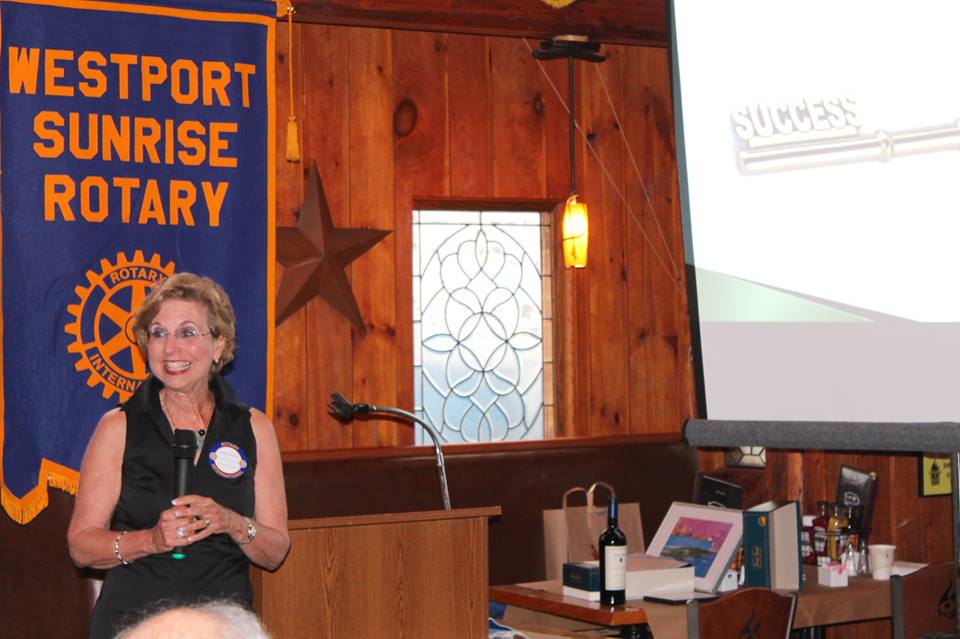July 11, 2014 marked the first meeting for the 26th edition of Westport (Connecticut) Sunrise Rotary. Education and communications consultant Peggy Bud gave Westport Sunrise Rotary a lively overview of Effective Communication. Peggy spoke about effective communication tools that help ensure business success. Since only 7% of any message are the words, she explained the impact a smile, handshake and eye contact has when communicating with clients, customers, and colleagues. She also told the audience that being an effective communicator takes practice!
“Effective communication is your key to success. Without it you can be good, but you’ll never be great.” And presentation doesn’t mean communication.
Communication begins with your first contact – with an associate, a client, a new patient. You have three seconds to make that first impression. The physical contact of a firm handshake as you make eye contact starts you off on the right foot. A robotic “hello” and a nod of your head doesn’t.
“Effective communication is engaging with your audience – and making sure they are engaged with you.” While I’m talking, she said, I’m watching you – are you listening, are you engaged – or are you just waiting to talk?
Ms. Bud’s presentation was about oral communication, but her headline was “your words are only seven percent of your message.” 38 percent is the “vocal part,” the way we put words together so others can hear them. The other 55 percent is non-verbal – the physical impression we make when we communicate.
Ms. Bud’s advice on the seven percent was to “make yourself easily understood,” use clear and concise sentences, avoid jargon and terminology your audience may not understand. If you use a PowerPoint, know it cold – or don’t use it. It’s a learning device for your audience, not a crutch for you.
The 38 percent, the “vocal” portion, is about using your voice, about “making your words valuable. Match your tone with your message.” Enunciate, project, pause for emphasis. If someone asks you to repeat your name, have you communicated effectively?
Speak at a rate your audience can take in your message, and use your voice to make your points – rising for what’s important, while making certain even the back row or the far table can hear everything. Keep your tone positive.
The most important part, Bud stated, is the non-verbal, “If we’re not communicating non-verbally we’re not communicating effectively.”
Your appearance and your actions complement your communication – or detract from it. If you’re in a small group you’ve already introduced yourself with a firm handshake, in a larger group you’ve started with a resonant “Good Morning Sunrise Rotary.” Make eye contact, smile. Bud added that when you’re on the phone people “can hear your smile,” just as they seem to know when you’re multi-tasking – that is, not paying attention.
Appearance is important. Dress for the occasion. How would you react to a speaker on a serious topic showing up in tennis clothes?
Posture tells a story. Standup straight. Command your audience’s attention, whether you’re a doctor meeting a new patient or a CEO presenting the quarter’s results to a room full of familiar faces.
Keep your hands in your pockets, cross your arms and you’re closing yourself off. Face the person you’re talking with, lean in, make open, inclusive, expressive gestures to tell your listener you’re engaging.
Facial expression also sends a strong message. “Let me know if I’m connecting – do they understand me, agree with me, do they have a question?”
“Effective communication takes practice. It is not an innate skill” Bud said. “Jay Leno epitomizes what I’m saying. He was the very first person at the studio every morning and the last to leave because he felt he had so much to do to prepare. He looked like he knew everything about everybody. But he prepared to be an effective communicator.”
How valuable is all this? Bud offered a quote from Warren Buffett – “Improving your communication skills can increase lifetime earnings by 50 percent.”
